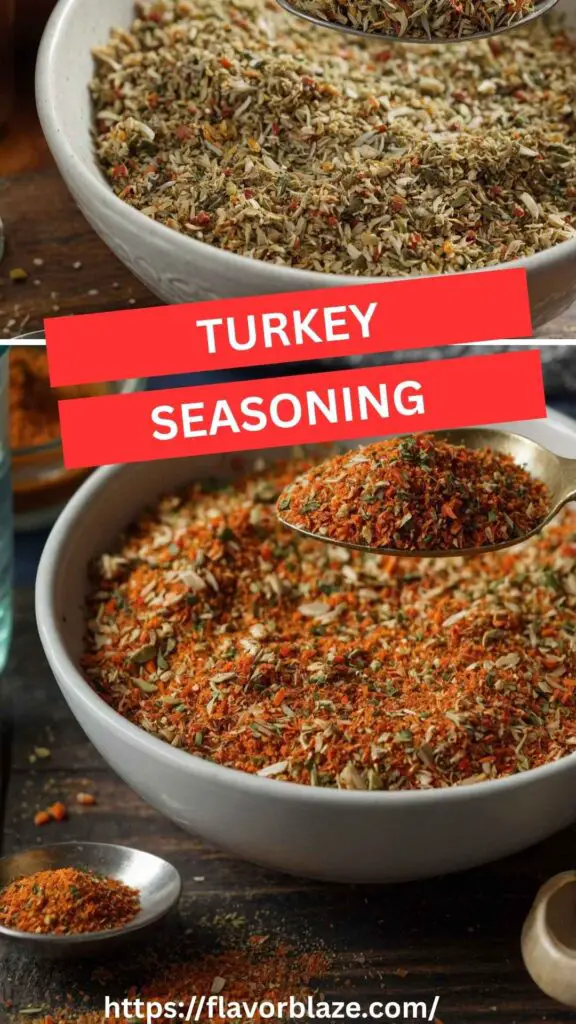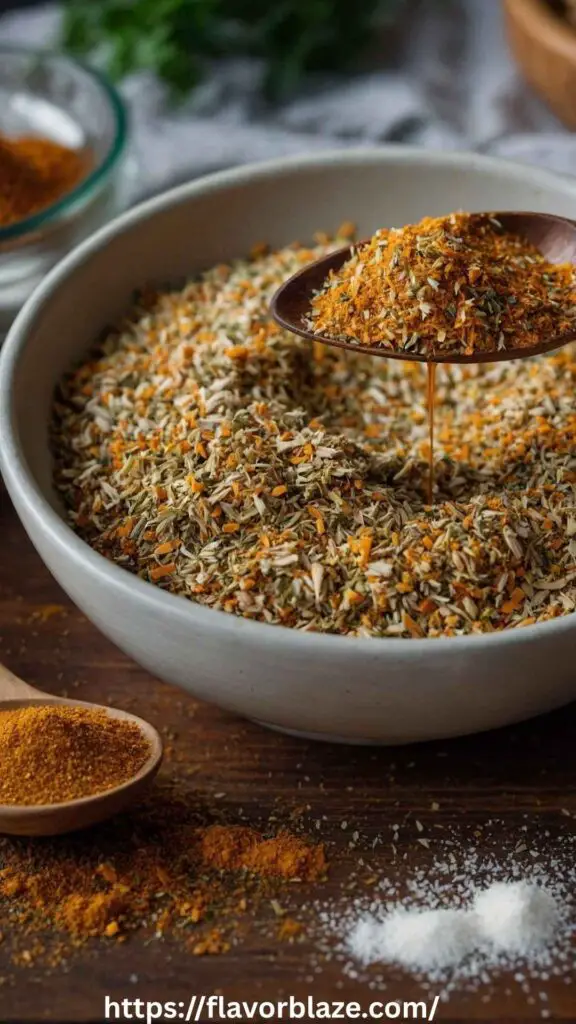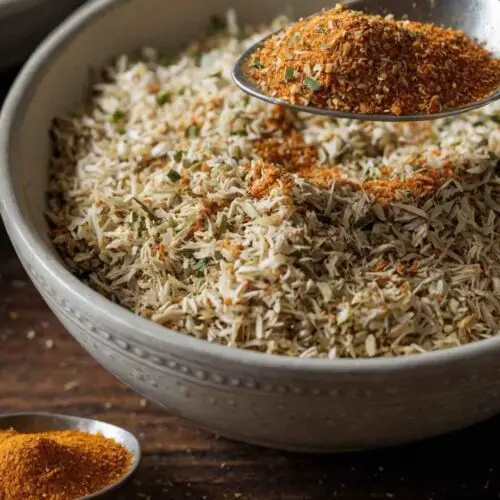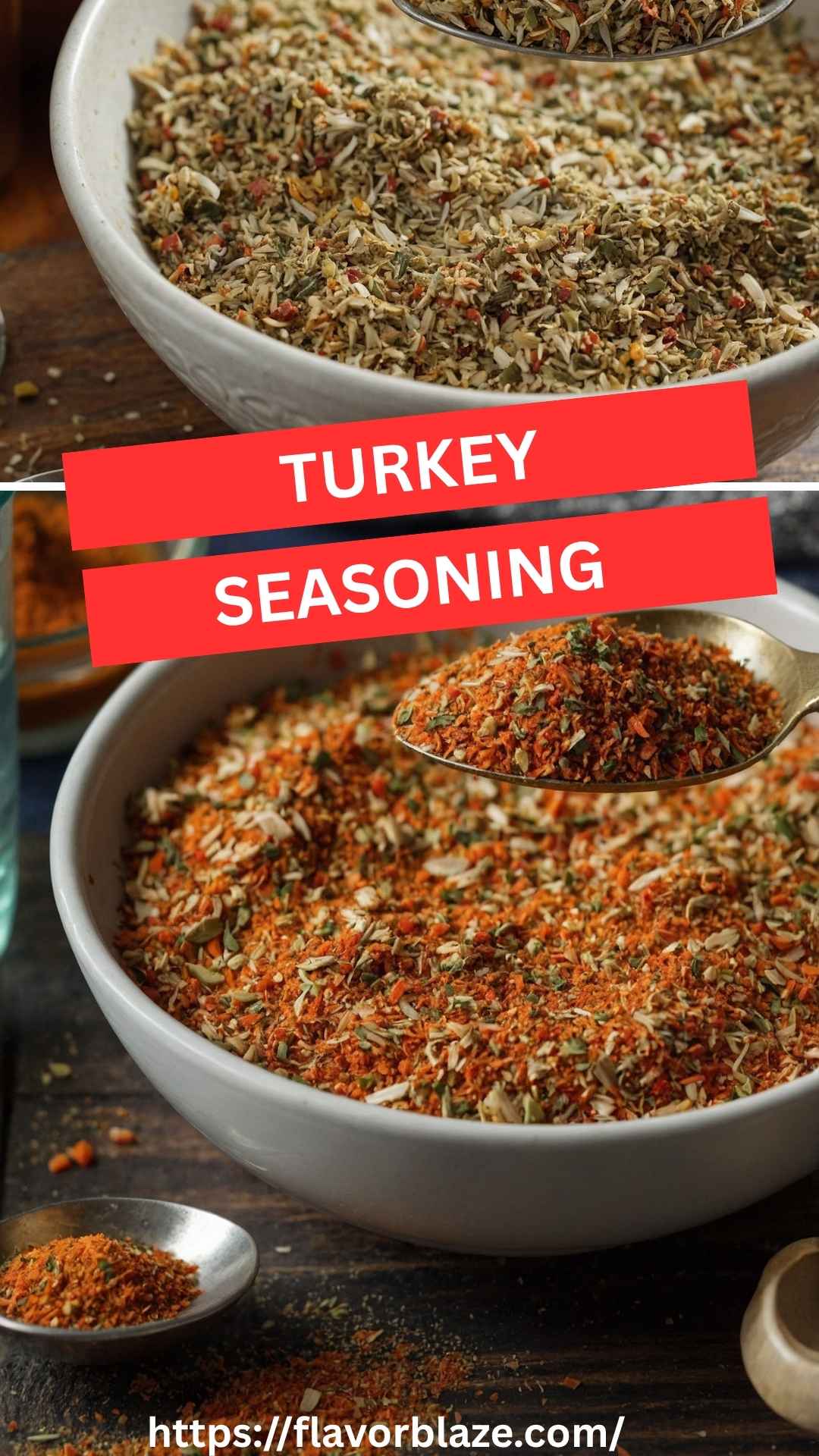When I think of turkey, my first thought is always how it blends seamlessly with various side dishes. Picture this: a beautifully roasted turkey—and there’s a vibrant array of sides laid out on the table.
I love pairing turkey with savory stuffing, which soaks up all those delicious juices. Cranberry sauce adds the perfect touch of sweetness. It balances the savory notes, making every bite complete. Plus, mashed potatoes topped with a dollop of gravy are an absolute must for any turkey dinner.
And let’s not forget about a fresh green bean almondine to add some crunch and color to the plate. These combinations create a feast that’s not just pleasing to the eye but also a delight to the palate.

You’ll Also Like These Recipes
Turkey seasoning is more than just a mix of spices; it’s the secret ingredient that elevates a plain turkey into something memorable.
As a registered dietitian and food enthusiast, I’ve spent years perfecting my turkey seasoning. Every Thanksgiving, family gatherings, or any occasion where turkey is the main course, my carefully crafted blend stands out.
Instead of relying on store-bought seasonings that often lack personality, I’ve learned that crafting my own blend can transform the ordinary into extraordinary. You’ll enjoy a burst of flavors that excite the taste buds and warm the heart.
So let’s dive into the world of turkey seasoning, where flavor takes center stage!
What is Turkey Seasoning?
Turkey seasoning refers to a blend of herbs, spices, and aromatics used to infuse flavor into turkey before cooking. It typically includes ingredients that enhance the natural flavor of the meat, making it moist and delectable.
Key components might include paprika for depth, garlic granules for punch, and herbs like sage and rosemary that evoke a homey vibe. Whatever the technique or method, the right seasoning makes all the difference.
What Does It Taste Like?
Imagine biting into a piece of turkey seasoned with a delightful blend of savory and slightly sweet notes. The smoked paprika brings a deep, earthy undertone, while the garlic adds a robust kick.
Sage lends herbal freshness, and brown sugar flirts with caramelization, adding a hint of sweetness that contrasts beautifully with the meat’s savory profile. It’s a taste that wraps you in warmth, nostalgia, and a craving for more.
Why This Recipe Works
- Flavor Complexity: Each ingredient in this turkey seasoning works together, creating layers of flavor that greet your palate.
Pomegranate’s subtle sweetness, paired with the smokiness of paprika, creates a balance that makes turkey enjoyable for everyone.
- Versatility: This seasoning isn’t just limited to turkey. You can sprinkle it on chicken, pork, or even tofu, giving you a handy mix for various dishes. Who doesn’t love a mix that can be multi-functional?
- Health-Conscious: The beauty of making your seasoning is that you control the sodium levels. When you opt for sea salt, you can adjust to your taste without compromising health.
- Homemade Goodness: There’s an undeniable satisfaction in crafting your seasoning. You avoid preservatives and artificial flavors. What’s in the jar is pure, simple, and utterly delicious. You’ll find yourself creating memories as you pass this recipe down through generations.
Ingredients for Turkey Seasoning
Here’s what you’ll need to create your turkey seasoning:
- 1 Tbsp. smoked paprika
- 1 Tbsp. dark brown sugar
- 2 tsp. garlic granules
- 2 tsp. dried sage leaves
- 2 tsp. ground rosemary
- 1 tsp. smoked chili powder
- 1 tsp. ground coriander
- 1 Tbsp. onion granules
- 2 Tbsp. sea salt
- 1 Tbsp. lemon zest seasoning

Step by Step Instructions
Step 1: Gather Your Ingredients
Start by measuring out all your ingredients into a small bowl. I recommend using measuring spoons for accuracy, but hey, even a pinch more of paprika never hurt anyone. The freshness of your ingredients will make a significant difference.
Step 2: Mix the Seasoning
Combine all the ingredients in the bowl. I like to use a whisk—it allows me to blend everything evenly and break up any clumps in the brown sugar. Mix until you have a uniform color and consistency.
Step 3: Taste Test
This is the fun part: give your seasoning a taste. Adjust according to your preference. Want it spicier? Add a pinch more chili powder. Don’t hesitate to make it your own.
Step 4: Store it Properly
Once you’re satisfied with the flavor, transfer the seasoning into an airtight container. A glass jar works perfectly here. Label it with the date, and it should last you a few months on your spice shelf.
Step 5: Use for Cooking
When it’s time to prepare your turkey, rub the seasoning generously onto the turkey. Ensure you season under the skin and inside the cavity for maximum effect. Let it sit for several hours or overnight; this intensifies the flavor.
Notes
- Experiment with Ratios: Don’t hesitate to tweak the ratios based on your taste preferences.
- Storage: Keep the seasoning in a cool, dark place. Avoid moisture; a dry environment extends shelf life.
- Add Fresh Herbs: For a kick of freshness, consider adding some freshly chopped herbs before cooking.
- Don’t Skip the Zest: The lemon zest seasoning really uplifts the meat, cutting through the richness.
- Double the Batch: If you cook turkey frequently, double or triple the batch so you always have some ready to go.
Nutrition Information
Turkey seasoning nutrition facts
How To Store The Leftovers?
After enjoying your turkey, any leftovers should ideally be stored in an airtight container in the fridge.
They can last about 3-4 days. For long-term storage, consider freezing slices of turkey wrapped tightly in plastic wrap and then placed in a freezer bag. Properly stored, your turkey can last for up to three months in the freezer.
Sides for Turkey Seasoning
To complete your meal, consider these delightful side dishes:
- Savory Stuffing: A mixture of bread, herbs, and vegetables that soaks up the turkey drippings. It’s a classic choice that complements turkey excellently.
- Cranberry Sauce: This tart sauce adds a refreshing contrast to the richness of turkey. Make a homemade version by simmering fresh cranberries with sugar and a hint of orange zest.
- Mashed Potatoes: Creamy mashed potatoes with a touch of butter and cream take comfort food to a whole new level. Make sure to have plenty of gravy on top.
- Green Bean Almondine: Sautéed green beans with toasted almonds offer a refreshing crunch. The vibrant green adds visual appeal and balances the meal with a fresh flavor.

Alternative Choices for Ingredients
In case you don’t have some of these ingredients, don’t worry! Here are alternatives:
- Smoked Paprika: If you can’t find smoked paprika, regular paprika or even a dash of cayenne pepper can work in a pinch, adding depth to your seasoning.
- Dark Brown Sugar: If you’re out of dark brown sugar, light brown sugar mixed with a tiny splash of molasses can yield a similar sweetness.
- Dried Sage Leaves: If sage isn’t in your pantry, try using thyme or oregano; they will still add a beautiful herbaceous note.
- Sea Salt: Regular table salt can replace sea salt, but remember that it’s finer, so use slightly less.

My Secret Turkey Seasoning Mix
Equipment
- Bowl
Ingredients
- 1 Tbsp. smoked paprika
- 1 Tbsp. dark brown sugar
- 2 tsp. garlic granules
- 2 tsp. dried sage leaves
- 2 tsp. ground rosemary
- 1 tsp. smoked chili powder
- 1 tsp. ground coriander
- 1 Tbsp. onion granules
- 2 Tbsp. sea salt
- 1 Tbsp. lemon zest seasoning
Instructions
Step 1: Gather Your Ingredients
- Start by measuring out all your ingredients into a small bowl. I recommend using measuring spoons for accuracy, but hey, even a pinch more of paprika never hurt anyone. The freshness of your ingredients will make a significant difference.
Step 2: Mix the Seasoning
- Combine all the ingredients in the bowl. I like to use a whisk—it allows me to blend everything evenly and break up any clumps in the brown sugar. Mix until you have a uniform color and consistency.
Step 3: Taste Test
- This is the fun part: give your seasoning a taste. Adjust according to your preference. Want it spicier? Add a pinch more chili powder. Don’t hesitate to make it your own.
Step 4: Store it Properly
- Once you’re satisfied with the flavor, transfer the seasoning into an airtight container. A glass jar works perfectly here. Label it with the date, and it should last you a few months on your spice shelf.
Step 5: Use for Cooking
- When it’s time to prepare your turkey, rub the seasoning generously onto the turkey. Ensure you season under the skin and inside the cavity for maximum effect. Let it sit for several hours or overnight; this intensifies the flavor.
Notes
- Experiment with Ratios: Don’t hesitate to tweak the ratios based on your taste preferences.
- Storage: Keep the seasoning in a cool, dark place. Avoid moisture; a dry environment extends shelf life.
- Add Fresh Herbs: For a kick of freshness, consider adding some freshly chopped herbs before cooking.
- Don’t Skip the Zest: The lemon zest seasoning really uplifts the meat, cutting through the richness.
- Double the Batch: If you cook turkey frequently, double or triple the batch so you always have some ready to go.
Nutrition
Frequently Asked Questions
1. Can I use this seasoning for other meats?
Absolutely! This turkey seasoning is versatile. You can use it for chicken or pork. Just adjust the quantity slightly according to the amount of meat you’re cooking.
2. How long can I store the seasoning?
If stored correctly in an airtight container away from light and moisture, this seasoning can last up to six months. Always check for freshness before use.
3. Can I make it gluten-free?
Yes! All the ingredients in this seasoning are naturally gluten-free. Just ensure that any replacements you make, especially for seasonings, are also gluten-free.
4. How can I spice it up even more?
For those who love heat, add more chili powder or even a pinch of cayenne pepper to the mix. Adjust according to your heat tolerance.
Conclusion
Turkey seasoning is a gateway to transforming an everyday dish into an extraordinary experience. With its skillful combination of flavors, it caters to diverse tastes and culinary creativity.
Crafting your own blend doesn’t just enhance the meal; it invites connections, conversations, and cherished memories around the table.
So go ahead! Gather your spices, mix up this seasoning, and savor every bite. Your turkey—and your guests—will thank you!





